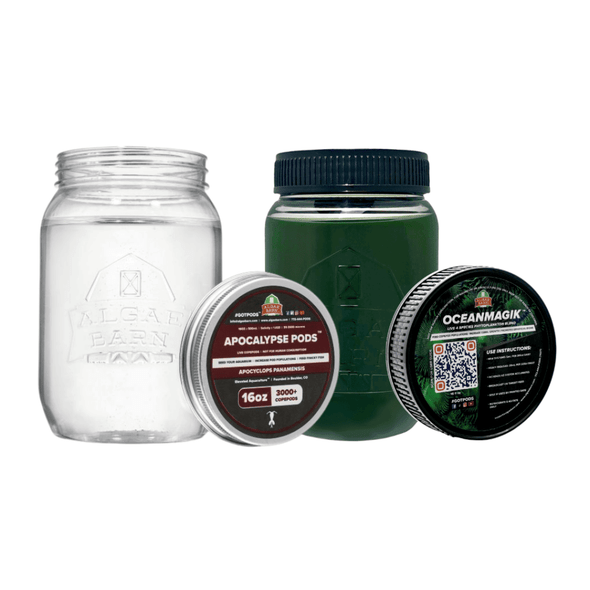Description
ALL-NEW DURABLE PACKAGING!
Each 16oz portion of Apocalypse Pods contains 3000+ LIVE Apocyclops Copepods ranging from nauplii to adult sizes. Apocalypse Pods are great for seeding new tanks and refugiums, boosting existing populations, or feeding finicky fish & inverts such as Mandarins, Seahorses, Anthias, Wrasses, SPS, LPS & NPS Corals, Clams, and most other filter-feeding inverts. Our pods are 100% viable to reproduce in marine aquaria. We recommend using with our high quality OceanMagik LIVE Phytoplankton Blend to establish and maintain the healthiest copepod populations.
OceanMagik is a unique blend of Four Live Phytoplankton species, specifically selected to provide your corals, Pods, and filter feeders a complete diet of highly nutritious essential fatty acids, proteins, vitamins, amino acids and carotenoids. OceanMagik will continuously feed your corals, clams, copepods, and other filter-feeding invertebrates. It is also designed to improve water quality by out competing nuisance algae for Nitrate and Phosphate. As the Live Phytoplankton in OceanMagik reproduces, it consumes nitrate and phosphate in the aquarium. This rapid growth leaves less of these chemicals available for use by unwanted algae; restricting unwanted algae growth. Only a LIVE product can offer both of these benefits as “dead” products do not reproduce and immediately begin decomposing into Nitrate and Phosphate. OceanMagik is a natural way to balance your tank and it will not cloud your water. Prolonged use of OceanMagik will also stabilize pH.
Shipping: Live Foods Ship on Select Days & Have a 100% Arrive Alive Guarantee
Apocyclops panamensis
These hardy copepods are slightly larger than Tisbe pods and slightly smaller than Tigriopus copepods. This intermediate size makes them a healthy live snack for your finicky fish and coral. Apocyclops copepods are extremely nutritious with a very high amino acid and protein content. Apocyclops copepods contain high amounts of Astaxanthin which can enhance and brighten the colors of your fish and coral. These warm water copepods reproduce extremely quickly by laying eggs every 4-6 days, about twice the rate of Tisbe and Tigriopus! Apocyclops copepods feed on phytoplankton, fish waste, and other detritus in your tank making them a critical part of any clean-up crew.
As juveniles, Apocyclops copepods are benthic meaning they stay hidden in the rock work, macro algae, and glass in your aquarium. As Apocyclops copepods mature into adults they lay eggs before becoming pelagic and making their way into the water column where they provide a sustainable and nutritious live food source for your fish and corals. The natural life cycle of the Apocyclops copepod makes them an ideal aquarium candidate and we are very excited to bring this new species into your tank!
What’s In It?
OceanMagik is a unique blend of the four Live Phytoplankton species described below:
“NANO”
Nannochloropsis gaditana :: Non-flagellated Yellow/Green :: 1 – 5 microns This tiny green algae consumes several nitrogen waste compounds including ammonia, nitrites, and nitrates. This helps if you have an overfeeding problem, if you are adding a new critter to your tank, or if you want to reduce the frequency of water changes.
“TET”
Tetraselmis sp :: Green Biflagellate :: 6 – 10 microns With a rich and varied amino/ fatty acid profile, Tetraselmis provides a very nutritional feed for your marine life and zooplankton. Due to its highly nutritional makeup, Tet is commonly used in large aquaculture facilities.
“ISO”
Isochrysis galbana :: Brown Biflagellate :: 10 – 14 microns This complex brown algae is high in DHA and often used to enrich zooplankton such as copepods and brine. Dosing your tank with Isochrysis will boost zooplankton and copepod levels. It will also help with the development, coloration, and resilience of your marine life. Isochrysis is the most commonly used algae for oysters, clams, mussels, and scallops
“THAL”
Thalassiosira weissflogii :: Unflagellated Diatom :: 5 – 32 microns Thal is the largest strain of phytoplankton we offer. As a beneficial diatom, this algae consumes silicates, restricting the growth of harmful dinoflagellates and silicates. It has also been shown to reduce cycle time in a new tank.











